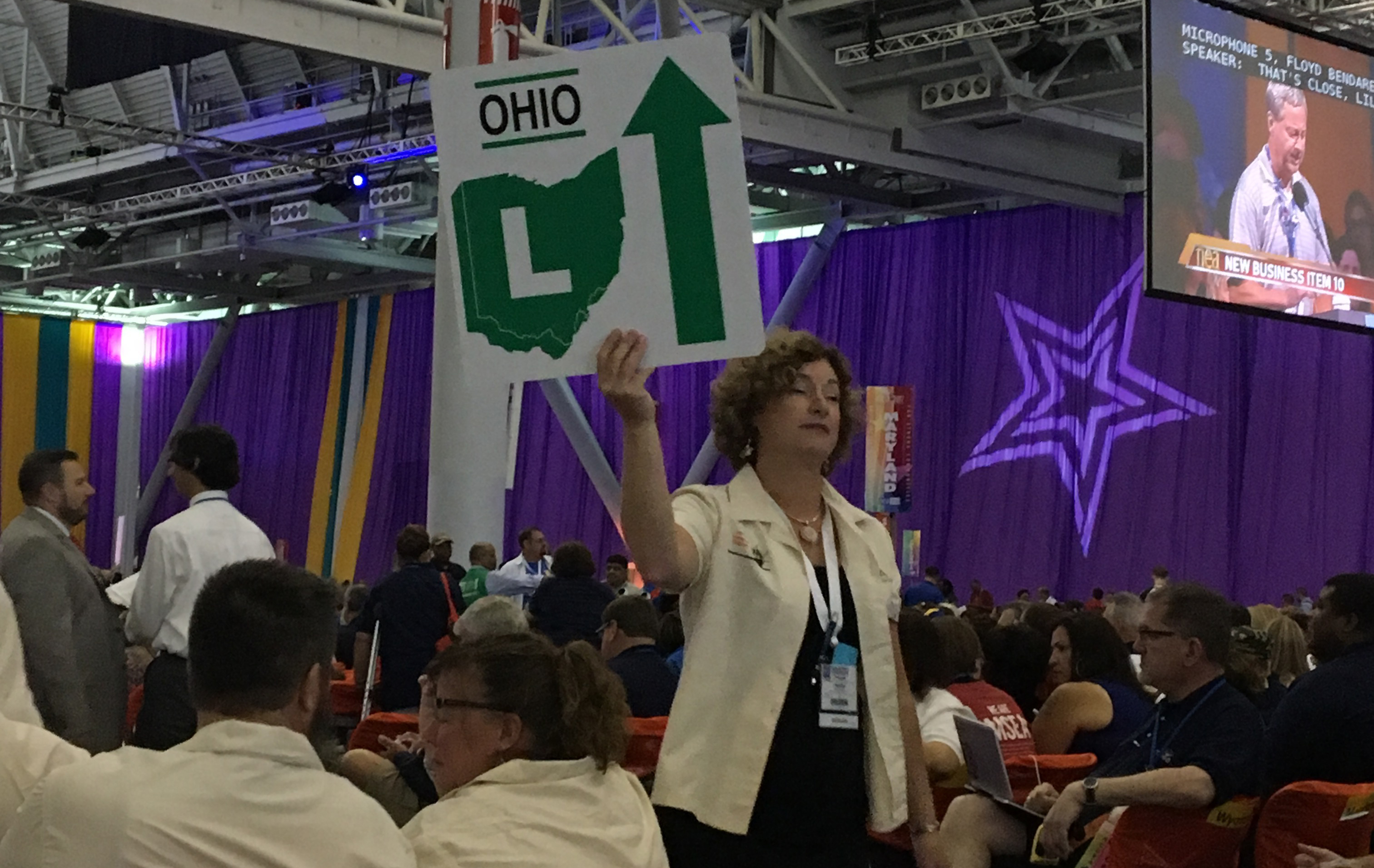OEA celebrates Public Education Matters Day with educators across the state
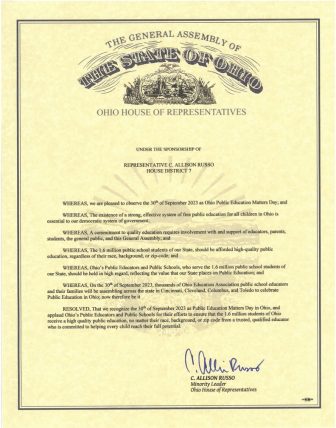
“Ohio’s public school educators have dedicated their lives and their careers to delivering the excellent public education that every child deserves – no exceptions. The Ohio Education Association was thrilled to be able to celebrate the passion and professionalism of our members at these regional rallies while strengthening our collective resolve to tackle the real issues facing our schools,” Ohio Education Association President Scott DiMauro said. “We must continue to use our united voice to demand the supports and resources our students, educators, and public school communities need to thrive, and we must ensure our educators are treated with the respect and dignity they’ve earned so education can be a sustainable profession that continues to attract high-quality professionals to serve our students.”
OEA launched the Public Education Matters initiative in spring 2023 as a galvanizing internal and public-facing campaign in its ongoing advocacy work to continuously improve Ohio’s public schools. “Together as one, Ohio’s educators, parents, and community leaders can achieve our vision for the excellent public schools Ohio’s students deserve,” DiMauro said. “Our strength is in our unity, and we will continue to speak in one strong, united voice because in Ohio, public education matters.”
In honor of the importance of public education in Ohio, the Ohio House issued a special commendation to OEA in recognition of its unfaltering commitment to continuously improving public education in our state. Additionally, the Ohio House Democratic Caucus approved a resolution recognizing September 30, 2023, as Public Education Matters Day in Ohio.
Images of OEA’s Public Education Matters Day rallies and member celebration events at the Columbus Zoo, Cleveland Zoo, Toledo Zoo, and Newport Aquarium are available on the Ohio Education Association Facebook page. A video with more information about the aims of the Public Education Matters initiative is available here.
VBlog | The Value of Membership
By Scott DiMauro, OEA President
Dear Colleagues,
It’s hard to believe that it’s been over a month already, but I can’t begin to tell you how much of an honor it is to serve as your OEA President. I am deeply grateful to Becky Higgins, Sheryl Mathis and Mark Hill for supporting me through this leadership transition, and I ask you to join me in welcoming Jeff Wensing as our new Vice President.
As a team, we have been crisscrossing the state to support your membership recruitment and engagement efforts, and we have had many incredible member ambassadors from our O.N.E. program leading that work as well.
While it’s too early to know about overall membership trends, we’ve been seeing a lot of enthusiasm as newly hired school employees are choosing to belong to our union all over Ohio. Many thanks to each of you for your efforts in ensuring we have a successful start to the 2019-20 school year.
I plan to share a brief weekly update on our successes, challenges and priorities starting next week. In the meantime, in case you haven’t seen it yet, I’d like to share a short video that our membership and communications team has put together on the value of membership. Please feel free to share it with prospective and returning members as you see fit.
At this exciting time of new beginnings, I wish you the very best for a great year.
Thank you for all you do for our fellow educators and the students we serve!
Sincerely,

Scott DiMauro
OEA President
President’s Message: Support, Protection, Power
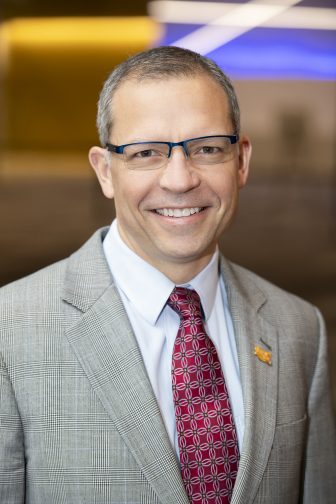
Our Union Helps Us Make Our Students’ Lives Better And Our Communities Stronger
I can’t begin to tell you how much of an honor it is to have the opportunity to serve as your president.
OEA is an incredible organization for two fundamental reasons: who we are, and why we’re here. We have caring, committed, qualified educators in all 88 of Ohio’s counties performing in a wide variety of roles who are united in a single cause—to ensure that every single one of our students is provided a quality public education that inspires their natural curiosity, imagination and desire to learn.
Driven by the desire to foster the critical thinking, problem-solving and decision-making skills my students needed to become effective citizens in our democracy, I became a high school social studies teacher 28 years ago. I didn’t go into education to help kids pass tests, but to create lifelong learners.
I wanted to make a difference, and I know you do too. That’s our purpose. That’s our mission.
That’s why I believe in you and your power to change lives and shape the future. My desire to make a difference naturally led to my active involvement in my local union.
I knew even before my first day of teaching American history at Tolles Technical Center in Plain City I would need the support of my colleagues if I had any hope of success.
That’s why I proudly joined the 45-member strong Tolles Education Association and soon found myself attending Labor- Management Committee meetings and advocating at the bargaining table.
As I continued my career in Worthington and through nearly three decades of activism at all levels of this organization, I have learned that it is only through our union that members are given the support and relationships to necessary to nurture our work with students. It is only through our union that we have the protection and advocacy needed to do our jobs without having to look over our shoulders. And it is only through our union that we are able to harness our collective influence and power to protect public education and improve the lives of our fellow educators and the students we serve.
“I wanted to make a difference, and I know you do too. That’s our purpose. That’s our mission.”
Many colleagues have supported and encouraged me throughout my union journey.
Wendy Nichols, my teaching mentor at Tolles, first invited me to belong to the association and provided me with opportunities to get involved in my local. Kathy Broom, who had been fired early in her marriage and teaching career simply for being pregnant and used the power of her union to successfully win her job back, helped me understand the power of collective advocacy. Suzanne Kaszar, my first OEA Labor Relations Consultant, taught me about bargaining and connected
me to programs to develop my leadership skills.
So many others have made a difference for me because they recognized my leadership potential and provided opportunities for me to play an active role in servingmy fellow members. It began with a simple invitation to belong to a movement that was larger than myself.
If you’re new to your role as an educator or education support professional, or if you have been in the profession for a while but have not yet become a member, I invite you to belong to the OEA and to tap into the support, protection and power your union has to offer.
If you’re returning as a member, I encourage you to be actively involved. Consider following the example Wendy provided to me and invite at least one colleague to join you and feel included. We’re all in this together.
I’m inspired by you and all that you do every day to make our students’ lives better and our communities stronger. You have challenged, nurtured and supported me throughout my union journey, and I look forward to continuing our journey together.
Sincerely,
![]()
Scott W. DiMauro, President
Ohio Education Association
The Hook of Standardization
Guest Blog | By Matt Jablonski, Elyria EA/OEA
 I have spent all but a few of my 20 years in education teaching a tested subject on which a student’s graduation is dependent. To say that this has had a negative impact on my career and the lives of my students is as obvious to me as the correlation between median income and standardized test scores.
I have spent all but a few of my 20 years in education teaching a tested subject on which a student’s graduation is dependent. To say that this has had a negative impact on my career and the lives of my students is as obvious to me as the correlation between median income and standardized test scores.
I am an American History teacher at Elyria High School, in one of Ohio’s urban districts. When the state planned its switch to the OGT, we were proactive. What we understood, what most educators understand, is that scores on standardized tests best correlate to economic status.
In a district with high rates of economically disadvantaged students, there would likely be high rates of students unable to graduate due to the tests. In an otherwise meaningless system, seemingly designed to see us fail, it was our job to get students to pass the assessment. Under the end–of-year assessments the same is true.
While some districts may not even need to think twice about their student’s success on state assessments, many of us need to place every ounce of our effort into strategies that point directly to an end game that has little to do with student college and career readiness, nothing to do with the joy of learning, and everything to do with an arbitrary score on a standardized test.
“An educational system driven by standardized assessments has run its course.”
In the interest of success in an urban district, educators like myself have tried to stay ahead of the curve. We have adopted new standards and adapted curriculum, written common assessments and analyzed the data. We used the language of assessments even though it’s not the vernacular of our students, found source material and written questions that look and sound like a standardized test. We taught the methods of responding to short answer and extended response questions even though their usefulness was restricted to state tests, and is utterly removed from any relevant academic writing outside of this environment. Despite the natural course of student interest, we paced ourselves to cram the content into the space and time prior to the spring assessment window.
 Predictably, we saw few victories, all relative to the level of poverty in a given district. And while the state of Ohio continues to insist that standardized tests are an accurate measure and the recipe for increased achievement, generations worth of data prove otherwise.
Predictably, we saw few victories, all relative to the level of poverty in a given district. And while the state of Ohio continues to insist that standardized tests are an accurate measure and the recipe for increased achievement, generations worth of data prove otherwise.
The Ohio Department of Education, in fits of madness only it understands, riddles its social media accounts with adept performances from the state superintendent celebrating students and teachers, as if we are too dimwitted to notice that they back assessment and evaluation systems designed to label us as failures.
Believe me, I remember the kids I’ve taught who didn’t pass their American History assessment. I remember their faces, the level of concern and anxiety. As teachers, we internalize these things. It is a part of sound compassionate practice. I’ve spent hundreds of hours developing and teaching remediation courses, so these students might have a shot to get the appropriate score on the second, or third, or fourth try.
The fundamental problem is, even when a student ultimately earns the required score, there is relief, but it’s not as if there is a great sense of accomplishment.
“Where is the meaning in being deemed successful in a meaningless system?”
No college or trade school is looking at the performance as a component for acceptance. No employer is interested either. The greatest predictor of college success is still Grade-Point Average, not standardized test scores.
What did we accomplish exactly?
Grinding out success in a system that expects you to fail can only carry you so far, and for teachers, there is always the next group of kids to deliver through the same awful system.
In a profession that is at its best when relationships and curiosity are nurtured, individuality and interest are paramount, and collaboration and creativity should be celebrated; all of us have been squeezed into an educational experience that celebrates standardization.
My career has been devoted to the necessary, but misguided task of trying to bring humor and joy to an education system that seems hell-bent on eliminating it, to introduce content steeped in relevance within a system that asks questions outside of any relevant context, to help students find meaning in a world where a major component of their education is utterly meaningless.
An educational system driven by standardized assessments has run its course. It is time for a change. #OverTestedOH
Matt Jablonski teaches American history teacher at Elyria High School in Lorain county.
You can follow Elyria EA on Facebook or visit their website: www.EyriaEA.ohea.us.
![]()
|
|
![]()
Benjamin Local Classified Employees Win Union Election

Joyce Fish loves her students. For 41 years, she has driven the students of the Benjamin Logan Local School District in her familiar yellow bus.
Located in eastern Logan county, near Bellefontaine, Ohio, the terrain can be challenging. “You learn to respect the weather, rugged hills, and steep valleys,” says Dan Fish; yes, Joyce’s husband and colleague.
However, after years of feeling they were not getting any love or respect from district administrators, in December 2017 they reached the Ohio Education Association.
Their efforts paid off — they’re no longer at-will employees and have a seat at the table. Results, tallied July 24, by the State Employment Labor Relations Board, show workers voted an overwhelming 73% in favor of OEA representation.
For the first time in more than 30 years, the district’s 70+ bus drivers, cafeteria workers, educational assistants, and paraprofessional aides will have will have union representation.
They will join the district’s 115+ educators of the Benjamin Logan EA, who have been a part of OEA since 1974.
Joyce and Dan say they’re looking forward to the collective-bargaining process. “Unanswered demands for respect as well as ‘fair and equal treatment for everyone,’ tell a story of professionals who are tired of being pushed around,” says Joyce.
![]()
 Oh Yes, We’re Social — Join the Conversation!
Oh Yes, We’re Social — Join the Conversation!
![]()
You Cannot Silence the Voice of Working People
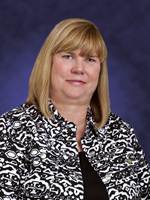
Teaching children is pretty wonderful.
This has been my passion and in the 19 years that I taught, I learned from and have been inspired by my colleagues. I have also been moved by the actions of fellow union members who fought for better wages and safe working conditions.
The energy we are seeing with teachers standing up in the neighboring states of West Virginia and Kentucky and elsewhere as the #RedForEd movement spreads across the country is unparalleled in recent history. Public opinion is with us. A recent poll found that 62% of Americans believe the country is better off with stronger unions.
Yet, while this happening, amid the highest level of support for unions in 15 years, the US Supreme Court in a narrow 5-4, politically-motivated decision ruled that unions – specifically public employee unions — should be weaker. The Supreme Court ruled in the case of Janus v. AFSCME, Council 31 to further tilt the playing field in favor of the wealthy and corporate interests.
The court overturned 40 years of precedent in deciding that requiring so-called fair-share fees to be paid by people who choose not to join a public-sector union but who enjoy the benefits of union representation somehow violates the First Amendment of the Constitution. This doesn’t make sense, and it’s not right.
It also doesn’t make sense that so many people are finding it difficult to get by and provide for their families, no matter how hard they work. It doesn’t make sense that people are more productive than ever, but they’re working longer hours for less money and fewer benefits. And it doesn’t make sense that all this is going on while a handful of very wealthy people have seen their salaries and holdings skyrocket. It is shameful that the wealthy special interests behind the Janus case have succeeded in manipulating the highest court in the land to do their bidding.
"I believe deeply in the power of our collective voice to make sure that every teacher and student has the resources they need to be successful."
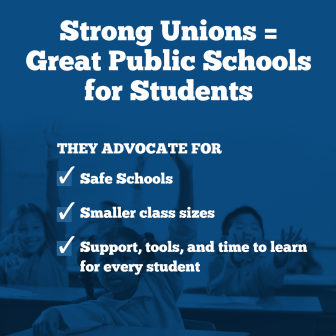
I believe deeply in the power of our collective voice to make sure that every teacher and student has the resources they need to be successful. When unions negotiate for working conditions in the classroom, they also negotiate for the conditions in which our children learn. When our unions advocate for us as educators, they also advocate for the students we serve.
Public service workers-teachers, social workers, firefighters, and nurses are more determined than ever to stick together in their unions. Unions remain the most effective vehicle for the power in numbers needed for working people to secure their rights and freedoms, and they provide a pathway to the middle class.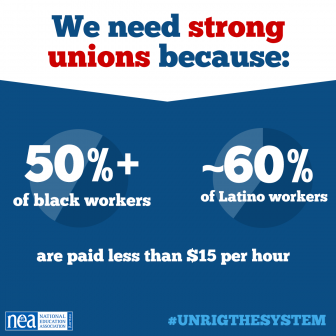
The truth is, when unions are strong, the entire community benefits. Unions use their collective voice to advocate for policies that help all working people — like increases to the minimum wage, affordable health care and great public schools.
Unions help close the pay gap for women and communities of color who have been systematically disadvantaged due to discrimination and prejudice.
African-American women in unions earn an average of $21.90 per hour, while non-union women earn $17.04. When Latinos are members of a union, their median weekly income increases by more than 38 percent.
The wealthy special interests that have benefited from an unfair, unbalanced playing field are now intent on tilting that playing field even more by attacking public-sector unions.
It’s driven by ideological extremists who oppose our basic right to organize. And it’s an attack on more than the men and women who are teachers and custodians and first responders; it’s an attack on anyone who wants to use their voice to fight for something better for their communities.
I have dedicated my life both to helping students and fighting for my community and I won’t back down.
My fellow educators and I are going to continue to speak out and I ask those who feel the same, please join us. Because no great social change — from ending slavery to securing the right to vote for every citizen, to winning the freedom to organize — has been achieved by standing alone.

Becky Higgins
President
Ohio Education Association
Categories
2018 Press ReleasesAbout Voices of Change
Education Support Professional
Higher Education Faculty
Higher Education Staff
Legislative Issues and Political Action
Local Leader
Member Stories
Membership
New Teacher
Non-educator
OEA Member
preK-12 Teacher
Retired Member
Student Member
What's New
The Sound of Silence … Worth the Consequences?
 One of the first lessons a child learns in school is to listen and be quiet. Silence is often desired in schools, unless we ask for participation. But lately, I’m beginning to wonder if we are doing our students a disservice when we emphasize the value of silence … because there is also a danger in certain kinds of silence.
One of the first lessons a child learns in school is to listen and be quiet. Silence is often desired in schools, unless we ask for participation. But lately, I’m beginning to wonder if we are doing our students a disservice when we emphasize the value of silence … because there is also a danger in certain kinds of silence.
As part of a study of Art Spiegelman’s Maus books and the Holocaust, my sophomores recently viewed a visual testimony of Kurt Messerschmidt. A young man during the Holocaust, he witnessed German soldiers forcing an older Jewish man to pick up some broken glass from the windows of a destroyed Jewish business on Kristallnacht. He noted that while he and a friend helped the old man pick up the glass, many other people stood by and said nothing. He believes that there were certainly other people who disapproved of the Nazis’ actions, but “Their disapproval was only silence, and silence was what did the harm.”[1] Sonia Klein, another Holocaust survivor who was interviewed after the riots in Charlottesville, warned that “Silence is the first thing after hate that is dangerous, because if you are silent, it’s an approval of what’s going on.”[2]
At the end of the Holocaust unit, I asked my students to read an article about Martin Niemoller[3] and his now famous words about remaining silent when other groups were persecuted and finding no one left to speak out for him when he was targeted. I asked my students how Niemoller’s words might apply today. One girl answered quite simply and succinctly: “We can apply these words to today by not allowing something that we wouldn’t want to happen to us to happen to somebody else.” She makes an excellent point. Maybe it’s not as simple as teaching the Golden Rule (do unto others as you would have done unto you). Maybe it’s time to teach kids to advocate for those being slighted or hurt in our world, even if they aren’t directly involved with the victims or the perpetrators.
In another class this week, my juniors read Walt Whitman’s poem “I Sit and Look Out”[4], a poem in which the speaker gazes out at “all the sorrows of the world, and upon all oppression and shame”. He lists several of those sorrows he observes in the world, including “treacherous seducer(s) of young women,” and “slights and degradations cast by arrogant persons upon laborers, the poor, and upon negroes, and the like.” The poem ends with the line “All these — All the meanness and agony without end, I sitting, look out upon,/See, hear, and am silent.” We discussed why the speaker in this poem (and people in general), upon seeing someone in need, choose silence over speaking out, and choose passive observation over direct action. My students mentioned greed, selfishness, and fear. They also decided that sometimes people may not even be aware of a need, or if they are, they might feel that one person’s actions or words would not make a difference.
My juniors were also familiar with Ralph Waldo Emerson’s belief that “for nonconformity, the world whips you with displeasure,” so I suggested that perhaps another reason people choose silence over action is that they have seen what has happened to others who spoke out. Colin Kaepernick peacefully protested an issue which plagues our society today (and which Whitman wrote about in his poem over a hundred years ago). And for that, Kaepernick lost his job. When other players knelt in solidarity with him, the President chimed in with profanity directed toward those players, critics berated the players who protested, and the news media, for weeks, was centered on this issue, this scandal, started by one man’s peaceful act of nonconformity and civil disobedience intended to speak out against an injustice. Heather Heyer, an anti-racism activist who went to Charlottesville to protest the hatred spewed by white supremacists, paid with her life for her efforts to stand up against an injustice.
So is speaking up worth it? It’s not as safe as remaining silent, that’s for sure, nor is it as easy. There are certainly repercussions that come from speaking our beliefs in “words as hard as cannon balls,” as Emerson implores us to do in “Self-Reliance”, and many of those consequences are not pleasant. But can our society afford to continue sitting by in silence as injustice and oppression happen around us?
Whitman’s poem “I Sit and Look Out” was written in the late 1800s. My students and I realized that of all the sorrows he lists, 13 in total, we still have every single one in our society today, with the exception of famine at sea. What does it say about humanity that over 150 years later, we have not figured out a way to eliminate these man (and woman)-made sorrows from our world? Where has silence gotten us?
As teachers, we can appreciate a quiet classroom, heads bent over desks, the only sound pencils scribbling as our students diligently work on an assignment. But I am going to make certain that in 2018, I make it a priority to teach my students the beauty of using their voices to break inappropriate silence and advocate for others. Maybe we can manage to address at least some of the sorrows that Whitman wrote about all those years ago if we help the next generation be equipped to do more than sit silently by and wait for someone else to take action.
[1] “Studying the Holocaust – Echoes & Reflections.” http://echoesandreflections.org/unit-1-studying-the-holocaust/. Accessed 16 Nov. 2017.
[2] “Holocaust survivor: Silence is ‘approval’ of racism – CNN.com.” 14 Aug. 2017, http://www.cnn.com/videos/us/2017/08/18/holocaust-survivor-warns-against-silence-charlottesville-nazis-sg-orig.cnn. Accessed 16 Nov. 2017.
[3] “Martin Niemöller: “First they came for the Socialists…”.” https://www.ushmm.org/wlc/en/article.php?ModuleId=10007392. Accessed 16 Nov. 2017.
[4] “83. I Sit and Look Out. Whitman, Walt. 1900. Leaves of Grass.” http://www.bartleby.com/142/83.html. Accessed 20 Dec. 2017.
Local Capacity
It takes all of us together to educate the child. And we all love what we do. We also know that whatever affects one is going to affect others, so we advocate and fight for our students and each other. That’s the benefit of belonging to a local association.
Strong Local Associations
Sharing your experiences and learning from each other — learning the right things and sometimes the wrong things to do — is easily done when you’re part of the network the Association offers.
Perceptions and Procedures
Lessons from the 2017 NEA RA
Anyone who reads social media related to the OEA/NEA can see that the perception of some of our colleagues is that OEA/NEA isn’t doing enough about certain issues, or worse, isn’t listening to members’ opinions. If that is your perception, let me assure you as a first-time delegate to the NEA RA (Representative Assembly) held this summer in Boston, that our union leaders are listening.
The bulk of the time spent at the NEA RA consisted of presenting and debating New Business Items (NBIs), proposed amendments to current NEA Resolutions, new policies, etc. Anyone could submit an issue or amendment to be discussed on the floor. In our morning meetings with our fellow Ohio delegates, we listened to the recommendations of various OEA committees who had reviewed the upcoming issues and whose members gave us a brief explanation of why they recommended either supporting or opposing the item/amendment. There was frequently a debate, and then the Ohio Caucus voted on a position to take. However, it was made very clear that any delegate could vote however he/she chose. At the RA later that day, with delegates from all states present, and often after very robust debate, we voted. An Ohio communications team held up signs reminding us what our Ohio Caucus decided about the item, but we were not obligated to follow that decision. Sometimes other delegates proposed an amendment to the issue at hand, and the Ohio Communications team then showed signs with our Leadership Team’s recommendation regarding the change. Still, delegates could vote however they wished.
And they did.
If you ever want to see democracy in action, all you have to do is observe the floor of any OEA/NEA RA. If the verbal vote is too close to call, a standing vote occurs. In Boston, I saw friends, colleagues, and roommates next to each other…one standing, one sitting. We sat as a group but we voted as individuals, and it was powerful to see so many people united in respectfully making their opinions known.
The debates leading up to these votes were epic (if you don’t believe me, look up NEA RA memes on twitter!). Sometimes, a debate occurred over one word. For example, we debated whether or not the word “powerful” should be used in an NBI to describe the NEA, and whether or not the word “zealously” should be used to describe a particular action. More substantial issues were debated as well, such as when the NEA should endorse presidential candidates and the new NEA policy on charter schools. At this year’s RA, there were 159 NBIs, three Constitutional Amendments, 12 Standing Rule Amendments, eight Legislative Amendments, 16 Policy Statement Amendments, and 31 Resolution Amendments submitted. Each of these were discussed and debated.
It was my first time attending the NEA RA, which is basically like the OEA RA amped up. I had attended the OEA RA before, and so I thought I knew what to expect. That wasn’t always the case. Some issues that I felt would have short discussions actually spark some of the fiercest debates. In all of these cases, my eyes were opened to another perspective that I had not considered. And in all cases, the voices of the delegates were heard. Sometimes my vote fell on the victorious side and sometimes my vote was for the side that got defeated, but I have no doubt that the end results represented what the majority of the delegates wanted.
Being able to understand how someone else perceives an issue often complicates matters. Understanding someone else’s perception can make your own convictions less black and white. It can muddy your positions. But hearing the viewpoints of other OEA and NEA members is an opportunity for which we should be grateful. It is something we should value, and after attending both an OEA RA and the NEA RA as a delegate for the state of Ohio, I very much appreciate that our association goes to such lengths to hear every viewpoint before voting as a body. I have learned a lot about the process of how the NEA forms its core beliefs and the actions it takes in the name of those beliefs. Because I care very much about the perception of my colleagues in the OEA, I want to assure you that our various viewpoints are being heard at both the state and national levels.
It is no easy task to formulate policies and recommend actions that represent the members of the largest union in the country. The viewpoints of others must be taken into account and there must be a process for allowing that to happen. For me, being a part of the largest democratic deliberative assembly in the world was alternately exhausting and exhilarating, frustrating and gratifying, mind-numbingly boring and absolutely inspiring. It is also categorically vital to maintain our mission to offer the highest quality public education in the world to our students, and to do so while advocating for economic and social justice, diversity, tolerance, and fairness in our schools and in our communities.
I urge you to attend an OEA or NEA RA if you are given the opportunity. I am extraordinarily grateful for the chance to witness firsthand how our union discusses, debates, deliberates, and ultimately decides how to best serve our students and promote our shared values in these challenging times.
Learn more about the OEA Representative Assembly.



